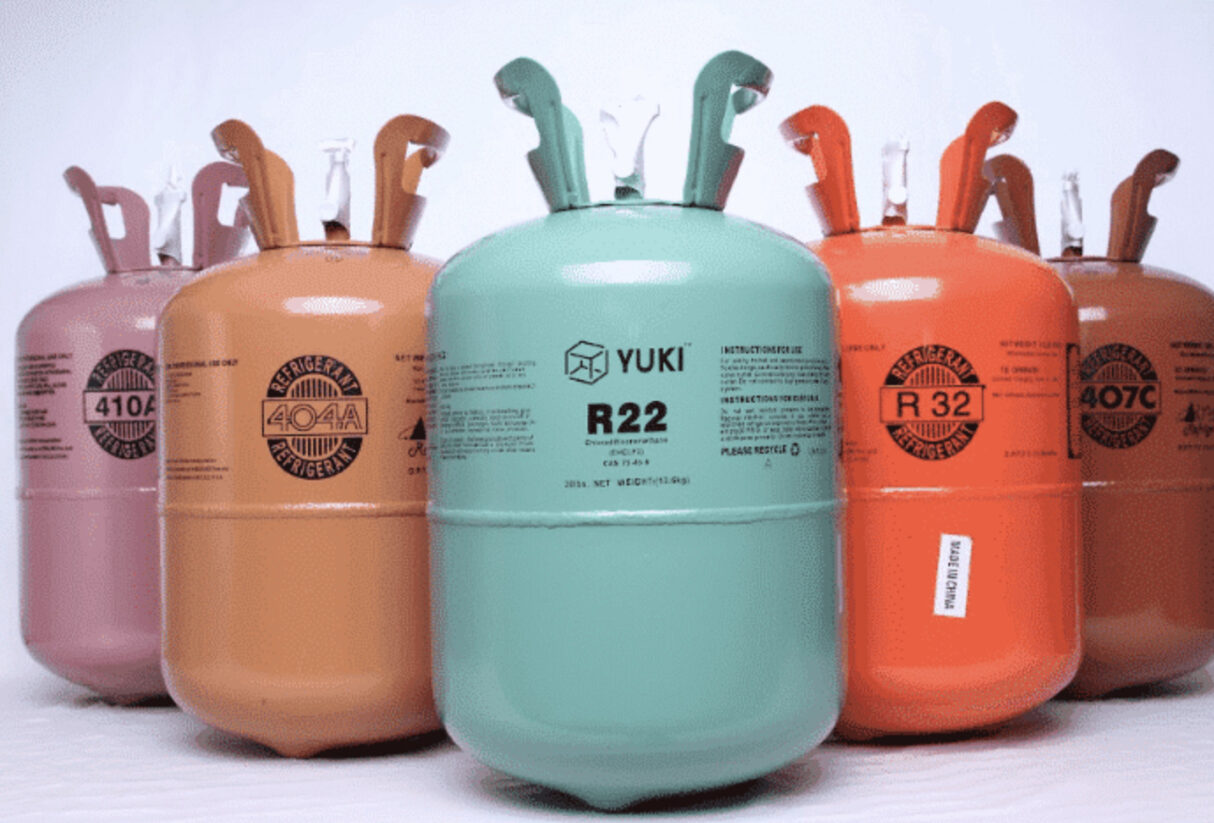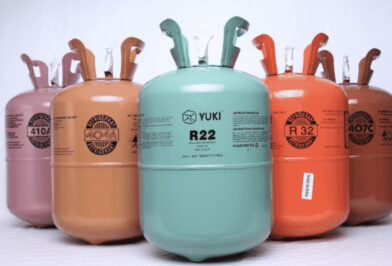Understanding R410 phase out and how it impacts your HVAC Business
In the world of heating, ventilation, and air conditioning (HVAC) systems, refrigerants play a crucial role in maintaining comfortable indoor environments. One such refrigerant that has gained widespread usage and popularity is R410. However, the HVAC industry is now facing a significant shift as countries around the globe are phasing out R410 refrigerant due to its environmental impact.
In this comprehensive blog post, we will delve deep into the intricacies of the R410 phase out. We will explore the composition and properties of R410 refrigerant, its advantages and applications, and the environmental concerns associated with its usage. Furthermore, we will discuss the reasons behind the phase-out, including global environmental regulations and initiatives, the Montreal Protocol, and the role of R410 in climate change.
Understanding the implications of the R410 phase-out is crucial for HVAC professionals, manufacturers, and consumers alike. We will examine the timeline and deadlines for the phase-out, the impact on the HVAC industry, and the financial considerations involved. Additionally, we will explore retrofitting and replacement options for existing systems, as well as the guidelines and considerations for transitioning to alternative refrigerants.
The transition to alternative refrigerants is a key aspect of the phase-out process. We will introduce various alternative refrigerants, analyze their advantages and disadvantages, and provide insights into retrofitting guidelines and considerations. Furthermore, we will explore future trends in refrigerant technology, offering a glimpse into the advancements and innovations that could shape the HVAC industry in the coming years.
By the end of this blog post, readers will have a comprehensive understanding of the R410 phase out, its implications, and the available options for transitioning to alternative refrigerants. Whether you are an HVAC professional seeking guidance on system upgrades or a concerned consumer aiming to make environmentally conscious choices, this blog post aims to provide you with the in-depth knowledge needed to navigate this important shift in the industry. Let’s dive into the world of R410 phase out and uncover the path to a greener HVAC future.
Understanding R410 Refrigerant
Refrigerants are a vital component of HVAC systems, playing a crucial role in the cooling and heating process. R410 refrigerant, in particular, has gained popularity in recent years due to its excellent performance and energy efficiency. In this section, we will explore the composition and properties of R410 refrigerant, its advantages and applications, as well as the environmental impact and concerns associated with its usage.
Composition and Properties of R410 Refrigerant
R410 refrigerant is a blend of two hydrofluorocarbon (HFC) compounds: R32 (difluoromethane) and R125 (pentafluoroethane). This unique combination results in a refrigerant with favorable thermodynamic properties, making it well-suited for air conditioning and heating applications.
One of the key properties of R410 is its high volumetric cooling capacity, meaning it can absorb and release a significant amount of heat per unit volume. This characteristic allows HVAC systems to operate efficiently, providing effective cooling and heating performance. Additionally, R410 has a relatively low boiling point, enabling it to absorb heat from the surrounding environment efficiently.
Moreover, R410 refrigerant exhibits excellent thermodynamic stability, which ensures consistent performance over a wide range of temperatures and pressures. This stability contributes to the overall reliability and longevity of HVAC systems that use R410.
Advantages and Applications of R410 Refrigerant
The adoption of R410 refrigerant in HVAC systems has been driven by several advantages it offers compared to other refrigerants. Firstly, R410 has a higher energy efficiency rating, known as the coefficient of performance (COP), compared to older refrigerants like R22. This improvement in efficiency translates into reduced energy consumption and lower operating costs for consumers.
Furthermore, R410 refrigerant operates at higher pressures than its predecessors, allowing for the design and implementation of more compact and lightweight HVAC systems. This characteristic is particularly beneficial for residential and commercial applications, where space limitations may exist.
R410 is commonly used in various air conditioning systems, including both residential and commercial units. It is widely employed in split air conditioning systems, heat pumps, packaged rooftop units, and other HVAC applications that require efficient cooling or heating. Due to its excellent performance and environmental friendliness, R410 has become the preferred choice for many HVAC professionals and manufacturers.
Environmental Impact and Concerns
While R410 refrigerant offers numerous advantages for HVAC systems, it is not without environmental concerns. Like other HFCs, R410 has a relatively high global warming potential (GWP) compared to other refrigerants. GWP is a measure of a substance’s contribution to climate change, with higher values indicating a greater impact.
The GWP of R410 is significantly higher than that of its predecessor, R22, as well as other commonly used refrigerants like R134a. This means that R410 has a greater potential to trap heat in the atmosphere, contributing to global warming and climate change.
Additionally, R410 does not contribute to ozone depletion, as it does not contain chlorine or bromine atoms. This makes it a safer alternative to older refrigerants like R22, which were phased out due to their detrimental impact on the ozone layer. However, the higher GWP of R410 has led to increased scrutiny and regulatory measures to limit its usage and encourage the adoption of more environmentally friendly alternatives.
In the next section, we will further explore the reasons behind the phase-out of R410 refrigerant, including global environmental regulations and initiatives. We will also delve into the Montreal Protocol and its role in the phase-out process. So, let’s continue our journey and uncover the motivations behind the R410 phase out.
Reasons for the R410 Phase Out
The phase-out of R410 refrigerant is not an arbitrary decision but is driven by global environmental regulations and initiatives aimed at mitigating climate change and protecting the ozone layer. In this section, we will explore the reasons behind the R410 phase-out, including the significance of global environmental regulations, the role of the Montreal Protocol, and the impact of R410 on climate change and human health.
Global Environmental Regulations and Initiatives
Concerns about the environmental impact of refrigerants have led to the establishment of global environmental regulations and initiatives. These regulations aim to reduce the usage of substances that contribute to climate change and ozone depletion, promoting the transition to more sustainable alternatives.
One of the key global environmental agreements driving the phase-out of ozone-depleting substances, including R410 refrigerant, is the Montreal Protocol. The Montreal Protocol, signed in 1987, is an international treaty designed to protect the Earth’s ozone layer by phasing out the production and consumption of substances that deplete it.
The protocol has been successful in reducing the production and consumption of ozone-depleting substances, resulting in the gradual recovery of the ozone layer. The phase-out of R410 refrigerant aligns with the goals of the Montreal Protocol, as it aims to eliminate substances with high global warming potential (GWP) and transition to more environmentally friendly alternatives.
The Montreal Protocol and the Phase Out of Ozone-Depleting Substances
The Montreal Protocol has set specific targets and deadlines for the phase-out of various ozone-depleting substances, including hydrochlorofluorocarbons (HCFCs) like R410 refrigerant. The protocol’s objectives include the complete elimination of these substances to allow the ozone layer to recover fully.
For R410 refrigerant, the Montreal Protocol has set a timeline for its phase-out, which varies across countries and regions. The phase-out involves a gradual reduction in the production, import, and usage of R410, ultimately leading to its complete elimination.
Non-compliance with the Montreal Protocol’s requirements can have significant consequences, including trade restrictions and penalties. Therefore, it is essential for HVAC professionals, manufacturers, and consumers to understand and adhere to the phase-out schedule to ensure regulatory compliance and contribute to global environmental efforts.
The Role of R410 in Climate Change
In addition to its impact on the ozone layer, R410 refrigerant also contributes to climate change due to its high GWP. GWP is a measure of a substance’s ability to trap heat in the atmosphere compared to carbon dioxide (CO2), which is assigned a GWP of 1.
The GWP of R410 is significantly higher than that of R22 and other commonly used refrigerants. This means that R410 has a greater potential to contribute to global warming and climate change over a given time period. As governments and organizations worldwide strive to reduce greenhouse gas emissions, the phase-out of R410 becomes a crucial step in achieving these goals.
By phasing out R410 and transitioning to alternative refrigerants with lower GWPs, the HVAC industry can significantly reduce its contribution to climate change. This shift aligns with international efforts to limit global warming and create a more sustainable future.
Health and Safety Concerns Associated with R410
Apart from environmental considerations, the phase-out of R410 refrigerant also addresses health and safety concerns associated with its usage. While R410 is generally considered safe under normal operating conditions, mishandling or improper installation can pose risks to human health.
R410 refrigerant is classified as an A2L substance, meaning it is mildly flammable and has a low toxicity level. While the flammability of R410 is relatively low compared to other flammable refrigerants, it still requires caution and adherence to safety guidelines during handling, installation, and maintenance.
HVAC professionals working with R410 must be trained in proper handling procedures and equipped with the necessary safety precautions to minimize the risk of accidents or exposure. By phasing out R410, the aim is to transition to alternative refrigerants with improved safety profiles, reducing potential hazards in HVAC systems.
In the next section, we will explore the implications of the R410 phase-out, including the timeline and deadlines for the phase-out, the impact on HVAC manufacturers and the industry, as well as retrofitting and replacement options for existing systems. So, let’s delve into the practical aspects of the R410 phase-out and understand its implications for the HVAC sector.
Implications of the R410 Phase Out
The phase-out of R410 refrigerant has significant implications for the HVAC industry, manufacturers, and consumers. In this section, we will explore the timeline and deadlines associated with the phase-out, the impact on HVAC manufacturers and the industry as a whole, retrofitting and replacement options for existing systems, and the financial and economic considerations involved.
Timeline and Deadlines for the Phase Out
The phase-out of R410 refrigerant follows a specific timeline and set of deadlines. It is important for HVAC professionals and consumers to be aware of these timelines to ensure compliance and proper planning.
The exact timelines and deadlines for the phase-out may vary across countries and regions. However, it is crucial to stay informed about the regulatory requirements in your specific location. Familiarize yourself with the phase-out schedule and understand the key milestones, such as the dates for discontinuing the production, import, and usage of R410 refrigerant.
By staying ahead of the phase-out schedule, HVAC professionals can effectively plan their projects, manufacturers can adjust their production processes, and consumers can make informed decisions about their HVAC systems.
Impact on HVAC Manufacturers and Industry
The phase-out of R410 refrigerant has a significant impact on HVAC manufacturers and the industry as a whole. Manufacturers need to adapt their production processes and develop systems that are compatible with alternative refrigerants. This transition requires considerable investment in research and development, as well as the retooling of manufacturing facilities.
Additionally, the phase-out affects the availability and pricing of HVAC systems. As the demand for alternative refrigerant-compatible systems increases, manufacturers may experience supply chain challenges and potential delays. This can lead to fluctuations in the pricing of HVAC systems, which may impact consumers and their decision-making process.
The industry as a whole must adapt to the phase-out by aligning their strategies with the transition to alternative refrigerants. This may involve training HVAC professionals on handling new refrigerants, updating service practices, and educating consumers about the benefits and implications of the phase-out.
Retrofitting and Replacement Options for Existing Systems
One of the key considerations during the R410 phase-out is the retrofitting or replacement of existing HVAC systems. Retrofitting involves modifying existing systems to accommodate alternative refrigerants, while replacement involves installing entirely new systems that are compatible with the phase-out requirements.
Retrofitting existing systems can be a viable option in some cases, depending on factors such as the age and condition of the system, the cost-effectiveness of the retrofit, and the availability of compatible alternatives. However, it is important to note that not all systems can be retrofitted, and in some cases, replacement may be the more practical choice.
When considering retrofitting or replacement options, it is crucial to consult with HVAC professionals who have expertise in the phase-out requirements and alternative refrigerants. They can assess the feasibility, cost-effectiveness, and safety aspects of retrofitting or replacement based on the specific circumstances of the system.
Financial and Economic Considerations
The R410 phase-out has financial and economic implications for HVAC professionals, manufacturers, and consumers. The transition to alternative refrigerants may involve additional costs, including the purchase of new systems, retrofitting expenses, and the training of HVAC professionals on handling alternative refrigerants.
However, it is important to consider the long-term benefits and savings associated with adopting environmentally friendly alternatives. Alternative refrigerants with lower GWPs can result in reduced energy consumption, leading to lower operating costs over the lifespan of the system. Additionally, complying with the phase-out regulations ensures regulatory compliance, avoiding potential penalties and trade restrictions.
Consumers should weigh the upfront costs against the long-term savings and environmental benefits when making decisions about retrofitting or replacing their HVAC systems. Seeking professional advice and conducting a cost-benefit analysis can help make informed choices that align with both financial and environmental considerations.
In the next section, we will delve into the transitioning process to alternative refrigerants. We will introduce various alternative refrigerants available, their advantages and disadvantages, retrofitting guidelines and considerations, and discuss future trends in refrigerant technology. So, let’s continue our exploration of the R410 phase-out and uncover the path to a greener HVAC future.
Transitioning to Alternatives
As the phase-out of R410 refrigerant progresses, the HVAC industry is actively exploring and transitioning to alternative refrigerants with lower global warming potentials (GWPs) and reduced environmental impact. In this section, we will introduce various alternative refrigerants, discuss their advantages and disadvantages, provide retrofitting guidelines and considerations, and explore future trends in refrigerant technology.
Introduction to Alternative Refrigerants
A wide range of alternative refrigerants is available as substitutes for R410. These alternatives include hydrofluorocarbons (HFCs), hydrofluoroolefins (HFOs), and natural refrigerants such as hydrocarbons (HCs) and carbon dioxide (CO2). Each alternative refrigerant has its own unique properties and characteristics, which make them suitable for specific applications and system requirements.
The selection of an alternative refrigerant depends on factors such as system compatibility, energy efficiency, safety considerations, and environmental impact. HVAC professionals and manufacturers need to carefully evaluate and choose the most appropriate alternative refrigerant based on these factors and specific project requirements.
Commonly Used R410 Alternatives
Several alternatives to R410 refrigerant have gained popularity in the HVAC industry. Some of the commonly used alternatives include:
It is important to note that each alternative refrigerant has its own unique considerations in terms of safety, flammability, toxicity, and system compatibility. Consulting with HVAC professionals or manufacturers with expertise in alternative refrigerants is essential to ensure the appropriate selection and implementation of the alternative refrigerant.
Pros and Cons of Alternative Refrigerants
Alternative refrigerants offer a range of advantages and disadvantages compared to R410 refrigerant. It is vital to consider these factors when evaluating the suitability of alternative refrigerants for a specific HVAC application.
Advantages of alternative refrigerants include:
Disadvantages and considerations of alternative refrigerants include:
When considering alternative refrigerants, it is essential to conduct a comprehensive evaluation of their pros and cons, considering factors such as system requirements, safety considerations, energy efficiency, and environmental impact.
Retrofitting Guidelines and Considerations
Retrofitting existing HVAC systems to accommodate alternative refrigerants requires careful planning and adherence to specific guidelines and considerations. Here are some essential guidelines and considerations for successful retrofitting:
Proper planning, consultation with experts, and adherence to safety guidelines are essential for successful retrofitting projects. HVAC professionals should stay updated with the latest guidelines and best practices related to retrofitting and alternative refrigerants.
Future Trends in Refrigerant Technology
The HVAC industry is continuously exploring new technologies and innovations to further improve refrigerant efficiency, reduce environmental impact, and address the challenges associated with the R410 phase-out. Some of the future trends in refrigerant technology include:
The ongoing research and development in refrigerant technology hold promising prospects for the HVAC industry. These advancements aim to address the challenges associated with the R410 phase-out while improving the overall sustainability and efficiency of HVAC systems.
As we move forward, it is crucial for HVAC professionals, manufacturers, and consumers to stay abreast of these advancements and align their strategies and decisions with the evolving landscape of refrigerant technology.
Transitioning to Alternatives
As the phase-out of R410 refrigerant progresses, the HVAC industry is actively exploring and transitioning to alternative refrigerants with lower global warming potentials (GWPs) and reduced environmental impact. In this section, we will introduce various alternative refrigerants, discuss their advantages and disadvantages, provide retrofitting guidelines and considerations, and explore future trends in refrigerant technology.
Introduction to Alternative Refrigerants
A wide range of alternative refrigerants is available as substitutes for R410. These alternatives include hydrofluorocarbons (HFCs), hydrofluoroolefins (HFOs), and natural refrigerants such as hydrocarbons (HCs) and carbon dioxide (CO2). Each alternative refrigerant has its own unique properties and characteristics, which make them suitable for specific applications and system requirements.
The selection of an alternative refrigerant depends on factors such as system compatibility, energy efficiency, safety considerations, and environmental impact. HVAC professionals and manufacturers need to carefully evaluate and choose the most appropriate alternative refrigerant based on these factors and specific project requirements.
Commonly Used R410 Alternatives
Several alternatives to R410 refrigerant have gained popularity in the HVAC industry. Some of the commonly used alternatives include:
It is important to note that each alternative refrigerant has its own unique considerations in terms of safety, flammability, toxicity, and system compatibility. Consulting with HVAC professionals or manufacturers with expertise in alternative refrigerants is essential to ensure the appropriate selection and implementation of the alternative refrigerant.
Pros and Cons of Alternative Refrigerants
Alternative refrigerants offer a range of advantages and disadvantages compared to R410 refrigerant. It is vital to consider these factors when evaluating the suitability of alternative refrigerants for a specific HVAC application.
Advantages of alternative refrigerants include:
Disadvantages and considerations of alternative refrigerants include:
When considering alternative refrigerants, it is essential to conduct a comprehensive evaluation of their pros and cons, considering factors such as system requirements, safety considerations, energy efficiency, and environmental impact.
Retrofitting Guidelines and Considerations
Retrofitting existing HVAC systems to accommodate alternative refrigerants requires careful planning and adherence to specific guidelines and considerations. Here are some essential guidelines and considerations for successful retrofitting:
Proper planning, consultation with experts, and adherence to safety guidelines are essential for successful retrofitting projects. HVAC professionals should stay updated with the latest guidelines and best practices related to retrofitting and alternative refrigerants.
Future Trends in Refrigerant Technology
The HVAC industry is continuously exploring new technologies and innovations to further improve refrigerant efficiency, reduce environmental impact, and address the challenges associated with the R410 phase-out. Some of the future trends in refrigerant technology include:
The ongoing research and development in refrigerant technology hold promising prospects for the HVAC industry. These advancements aim to address the challenges associated with the R410 phase-out while improving the overall sustainability and efficiency of HVAC systems.
As we move forward, it is crucial for HVAC professionals, manufacturers, and consumers to stay abreast of these advancements and align their strategies and decisions with the evolving landscape of refrigerant technology.
Conclusion
With the phase-out of R410 refrigerant, the HVAC industry is undergoing a significant transition towards more sustainable and environmentally friendly alternatives. The shift is driven by global environmental regulations, initiatives to mitigate climate change, and the need to protect the ozone layer. The selection of alternative refrigerants requires careful consideration of their properties, compatibility with existing systems, safety aspects, and environmental impact.
The introduction of alternative refrigerants, such as R32, R454B, R407C, and natural refrigerants like hydrocarbons and CO2, offers viable options for retrofitting or replacing existing R410 systems. Each alternative refrigerant has its own set of advantages and disadvantages, and HVAC professionals should evaluate them based on system requirements, safety considerations, energy efficiency, and overall environmental impact.
Retrofitting existing systems requires proper planning, system assessment, and adherence to safety guidelines. HVAC professionals should consult with experts and ensure compliance with regulations to achieve optimal performance and safety. Replacement of systems may be necessary in cases where retrofitting is not feasible or cost-effective, especially for older systems that may not be compatible with alternative refrigerants.
The financial and economic considerations of the R410 phase-out should also be taken into account. While the transition to alternative refrigerants may involve upfront costs, the long-term benefits of reduced energy consumption, lower operating costs, and environmental sustainability should be considered. Making informed decisions based on a comprehensive cost-benefit analysis can help ensure the best outcomes for HVAC professionals and consumers alike.
As the HVAC industry continues to evolve, future trends in refrigerant technology offer promising advancements. Ongoing research and development focus on developing low-GWP refrigerants, blends and mixtures, and advancements in natural refrigerants and system designs. Staying informed about these developments will enable stakeholders to make informed choices and remain at the forefront of the industry.
In conclusion, the phase-out of R410 refrigerant marks a crucial step towards achieving a greener and more sustainable HVAC industry. The transition to alternative refrigerants presents opportunities for improved energy efficiency, reduced environmental impact, and compliance with global environmental regulations. By embracing these changes, HVAC professionals, manufacturers, and consumers can contribute to a more sustainable future and create a healthier environment for generations to come.



